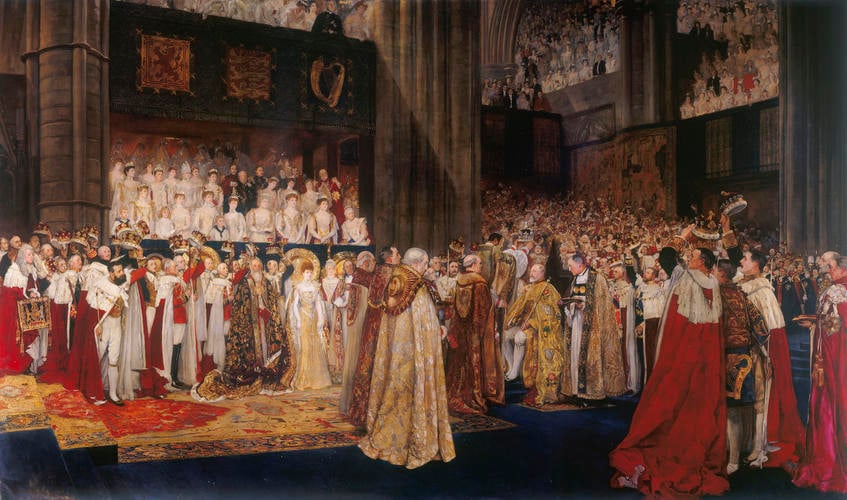-
1 of 253523 objects
The Coronation of King Edward VII (1841-1910) c. 1902-7
Oil on canvas | 275.0 x 458.0 cm (support, canvas/panel/stretcher external) | RCIN 404612
-
The moment depicted is when the Archbishop of Canterbury, with arms lifted, is about to place the Imperial Crown on the head of Edward VII, who is seated, clothed in robes of State, in the Coronation chair. Princes and peers raise their coronets and lead the shout ‘God Save the King’. Beside the King stands the Bishop of Bath and Wells, behind whom are the Prince of Wales, the Duke of Connaught and the aged Duke of Cambridge. Within months of his accession King Edward VII had approached John Singer Sargent (1856-1925) to ask him to paint the official Coronation portrait. However, Sargent felt unfit for the task, and declined. On 12 March 1901, Locket Agnew, of Thomas Agnews & Sons, proposed a scheme for the King’s approval to paint a large painting of the Coronation. Agnew asked for the King’s authorisation to call the painting ‘the only official picture of the Coronation’. It was proposed to exhibit the painting for a period of five years both in the United Kingdom and perhaps also in the USA and Canada and that sales of an engraving to be made of the painting would accrue to Agnews. Within five years the painting would be presented as a gift to Edward VII. The painter who had been selected by Agnews was Edwin Austin Abbey who had already ‘expressed his willingness to carry out such a picture’. Sir Arthur Ellis endorsed their choice: ‘As to E Abbey’s [sic] artistic merits, probably they are wise in choosing him – He has taken Frith’s place for such pictures & is for these subjects the best man’. The original date of the Coronation was set for 26 June 1902. During preparations and rehearsals in Westminster Abbey the artist had been able to prepare sketches and fill in positions of the main participants of the ceremony. Later he reported: ‘it was fortunate I had been able to sketch at the rehearsals or I should have been in a great muddle’. However, due to the King’s ill-health the coronation had to be postponed and was re-scheduled for 9 August 1902. The artist’s viewpoint was a specially built box in the tomb of Edmund Lancaster in the north transept. Unfortunately, it was a dull day and Westminster Abbey appeared more than usually gloomy and dark. But despite this Abbey was profoundly impressed with what he saw: ‘It was a sight indeed. They had white satin dresses and long trains of crimson velvet and ermine capes – trains and their coronets in hands. They came by twos or threes and dozens, and were marvellous to behold. I never saw so many jewels in my life.’ The Danish artist, Laurits Tuxen (1853-1927), entrusted to paint a more private painting of the Coronation (see RCIN 404487), found the occasion similarly impressive and daunting. However, it appears that in February 1906 Abbey was still working on the project and he later declined to produce the Coronation painting of King George V. This task was undertaken by John Henry Frederick Bacon (1865-1914) ( RCIN 407572) and Tuxen (RCINs 404478, 407287). Yale University Art Gallery hold five studies of the coronation and numerous pastel portrait sketches (Edwin Austin Abbey Memorial Collection).
Provenance
Commissioned by Thomas Agnew & Sons Ltd from the artist in 1901; presented to King Edward VII; recorded in Buckingham Palace, on the Visitors Landing in 1909
-
Creator(s)
Acquirer(s)
-
Medium and techniques
Oil on canvas
Measurements
275.0 x 458.0 cm (support, canvas/panel/stretcher external)
320.5 x 503.0 x 17.0 cm (frame, external)
272.0 x 455.5 cm (sight)
277.0 x 460.0 x 5.0 cm (frame, rebate)
Alternative title(s)
The Coronation of Edward VII (1841-1910), Westminster Abbey, 9 August 1902.
